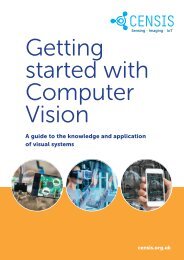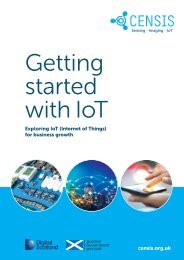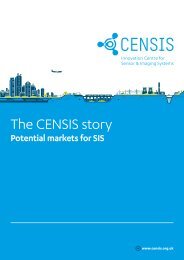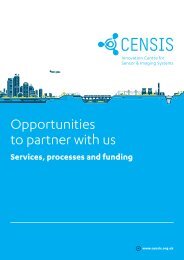CENSIS white paper: Intellectual Property in Business
2023: This CENSIS white paper sets out to make the topic of IP more approachable, less intimidating and more manageable, offering experience-based advice and methods are are designed to help businesses structure their IP- related issues and makes the best of their IP. Covering: The role of IP, IP management during growth, IP strategy for expanding companies and corporates, Business IP Canvas - merging IP with your business model.
2023: This CENSIS white paper sets out to make the topic of IP more approachable, less intimidating and more manageable, offering experience-based advice and methods are are designed to help businesses structure their IP- related issues and makes the best of their IP.
Covering:
The role of IP, IP management during growth, IP strategy for expanding companies and corporates, Business IP Canvas - merging IP with your business model.
You also want an ePaper? Increase the reach of your titles
YUMPU automatically turns print PDFs into web optimized ePapers that Google loves.
<strong>Intellectual</strong> <strong>Property</strong> <strong>in</strong> Bus<strong>in</strong>ess: IP basics, IP management, IP strategy<br />
IP Strategy for Expand<strong>in</strong>g Companies and Corporates (cont<strong>in</strong>ued)<br />
Table 11 IP strategic questions See page 42 for footnotes<br />
Question<br />
Comment<br />
Competitive advantage<br />
1. Where do you seek your Even if your competitive advantage is not based on technology, this<br />
competitive advantage?<br />
<strong>in</strong>formation constitutes one or more critical trade secrets.<br />
2. What are the strengths of your See above.<br />
company?<br />
3. Could you obta<strong>in</strong> a significant You could consider leverag<strong>in</strong>g your competitive advantage, for example,<br />
competitive advantage over your through an IP-based ‘isolat<strong>in</strong>g mechanism’.<br />
competitors by us<strong>in</strong>g your exist<strong>in</strong>g IP<br />
or by register<strong>in</strong>g new IP?<br />
4. Are there important ways IP could Options could <strong>in</strong>clude ensur<strong>in</strong>g the company has IP ownership, monetis<strong>in</strong>g<br />
provide support to your bus<strong>in</strong>ess IP through licens<strong>in</strong>g, attract<strong>in</strong>g R&D projects/collaborations, or strengthen<strong>in</strong>g<br />
strategy? What are they?<br />
your negotiat<strong>in</strong>g power.<br />
Your <strong>in</strong>dustry and target market<br />
You could consider rank<strong>in</strong>g your IP rights and identify<strong>in</strong>g potential market<br />
players for out-licens<strong>in</strong>g. You could identify them through, e.g., patent analyses<br />
5. How important are <strong>in</strong>ventions and IP Although it is hard to imag<strong>in</strong>e an <strong>in</strong>dustry sector that would ignore<br />
<strong>in</strong> your <strong>in</strong>dustry and target market? <strong>in</strong>novations, some sectors seem to pay more attention to generat<strong>in</strong>g<br />
<strong>in</strong>ventions and IP protection than others. Th<strong>in</strong>k, for example, about biotech<br />
and consumer electronics, vs coffee and carpet manufactur<strong>in</strong>g.<br />
6. How sophisticated is your <strong>in</strong>dustry Awareness of how competitors use their IP – e.g., purely as an isolat<strong>in</strong>g<br />
about IP practices?<br />
mechanism, quickly grow<strong>in</strong>g patent portfolios, sell<strong>in</strong>g IP, licens<strong>in</strong>g IP – is a<br />
crucial data po<strong>in</strong>t that might <strong>in</strong>dicate a w<strong>in</strong>dow of opportunity. For example,<br />
you might break the standard practice of lock<strong>in</strong>g IP <strong>in</strong>to the company and<br />
offer a brand-new bus<strong>in</strong>ess model <strong>in</strong> the sector such as crowd-sourc<strong>in</strong>g new<br />
applications, or use the flexibility of the <strong>in</strong>dustry and out-license your IP to<br />
share commercial risk or ga<strong>in</strong> a royalty return.<br />
7. Are IP rights respected and enforceable IP is not just about litigation. However, if you feel strongly about enforc<strong>in</strong>g<br />
<strong>in</strong> your target markets/territories? your IP rights, and this presents a challenge <strong>in</strong> your target markets/territories,<br />
you need to revise your approach. Perhaps this po<strong>in</strong>t should have a lower<br />
priority <strong>in</strong> terms of IP purposes? A good IP portfolio might facilitate R&D<br />
cooperation and be a strong card <strong>in</strong> negotiations with <strong>in</strong>vestors and other<br />
bus<strong>in</strong>ess partners.<br />
Innovation process<br />
8. How do you <strong>in</strong>tend to position Do you aspire to deliver ‘cutt<strong>in</strong>g-edge’ technology? Do you want to create a<br />
yourself <strong>in</strong> the market <strong>in</strong> terms of company known for its <strong>in</strong>novative spirit?<br />
your ability to <strong>in</strong>novate?<br />
A solid and strong IP portfolio (of diverse IP rights, not only patents) can<br />
express this goal very well. Also, a grow<strong>in</strong>g IP portfolio will demonstrate the<br />
results of your tech development efforts.<br />
9. How do your company’s <strong>in</strong>novation This is all about reta<strong>in</strong><strong>in</strong>g/establish<strong>in</strong>g your company’s cutt<strong>in</strong>g edge. Rely<strong>in</strong>g<br />
processes compare with those of the on serendipity is not a strategy. At the same time, this approach is not about<br />
competition?<br />
over-formalis<strong>in</strong>g the freedom to generate ideas/<strong>in</strong>ventions. Def<strong>in</strong><strong>in</strong>g the<br />
stages of an <strong>in</strong>novation process, the requirements, and <strong>in</strong>volv<strong>in</strong>g various<br />
departments/groups can support the <strong>in</strong>flow of ideas and will eventually lead<br />
to the successful implementation of a new product. An adequately tailored<br />
<strong>in</strong>novation process generates useful IP. 78<br />
10. How long are product lifecycles <strong>in</strong> Consider whether patent protection is appropriate, even if your solution is<br />
your target market?<br />
patentable. If the product lifecycle is very short, i.e., under five years, I would<br />
always encourage you to do your own analysis to understand which aspects<br />
of your solutions are the most crucial for your bus<strong>in</strong>ess and whether they<br />
have long-term opportunities to support further product development. Th<strong>in</strong>k<br />
which elements of your solution would make the most out of long-term<br />
patent protection. You might consider look<strong>in</strong>g at your value proposition<br />
(see Appendix 2).<br />
11. Do you plan any scientific publications If you aspire for patent protection, your own publications prior to the patent<br />
about your solution?<br />
fil<strong>in</strong>g create the state of the art and are detrimental <strong>in</strong> terms of the novelty<br />
criterion for your patent applications.<br />
43

















